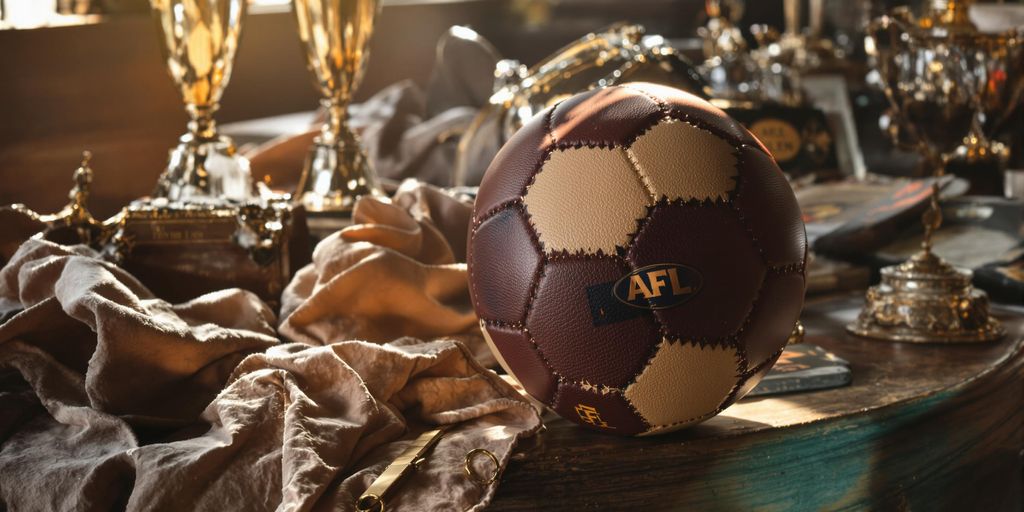The Birth Of Australian Football
Origins Of The Game
The story of Aussie Rules is a wild one, a true blue blend of different influences. It wasn’t just plucked out of thin air, you know? Some say it’s got roots in Gaelic football and rugby, brought over by the early settlers. But there’s also a strong argument that it was shaped by Indigenous games, like Marn Grook, played by Aboriginal people for centuries. This mix of cultures and sporting traditions is what makes Australian football so unique. It’s a game born from the land and the people who call it home. It’s a sport that’s as Aussie as a meat pie at the footy.
Early Rules And Regulations
Back in the day, things were a bit loose, not like the super-structured game we see today. The first rules were drawn up in 1859 by Tom Wills, W.J. Hammersley, J.B. Thompson and Thomas Smith, aiming to keep cricketers fit during the off-season. Imagine that! These blokes probably had no idea they were starting a national obsession. The early rules were pretty basic, focusing on kicking the ball between two posts, but they laid the foundation for what would become a complex and strategic game. Over time, the rules evolved, with changes to tackling, marking, and scoring, all shaping the sport into what it is now. It’s a constant evolution, always tweaking and refining to make the game better.
Formation Of The VFA
The Victorian Football Association (VFA) was a big deal, the first real organised competition for the sport. It was formed in 1877, bringing together the various clubs that had sprung up around Victoria. This was a crucial step in formalising the game and giving it a proper structure. The VFA early rules helped to standardise the rules and create a more consistent playing experience. It also fostered rivalries and a sense of competition that drove the sport forward. The VFA was the precursor to the VFL (Victorian Football League), which eventually became the AFL (Australian Football League), the national competition we know and love today.
The VFA played a vital role in shaping the early landscape of Australian football. It provided a platform for clubs to compete, develop their skills, and build a following. It was a time of great passion and innovation, as the game was still finding its feet. The VFA laid the groundwork for the future success of Australian football, paving the way for the national competition that would eventually emerge.
Here’s a quick look at some of the founding clubs of the VFA:
- Carlton
- Geelong
- Melbourne
- Essendon
- South Melbourne
Carlton Football Club: A Legacy
Foundation Year And Early Success
Carlton, established way back in 1864, stands as one of the oldest footy clubs around. It predates many famous sporting institutions worldwide! In those early days, the team quickly made a name for itself, securing the South Yarra Presentation Challenge Cup in 1871. They were also considered the top team in the competition for a few years in the 1870s, and snagged VFA Premierships in 1877 and 1887. It was a time of establishing a strong foundation and building a winning culture.
Significant Achievements
Carlton’s trophy cabinet is pretty impressive, boasting 16 VFL/AFL premierships. They’ve consistently been a force to be reckoned with, producing some of the game’s most memorable moments. They’ve had some tough times, sure, but the club’s history is filled with periods of dominance and memorable grand final victories. It’s a legacy built on hard work, skill, and a never-say-die attitude.
Cultural Impact On The Community
Carlton is more than just a footy club; it’s a part of the community’s fabric. For generations, families have supported the Blues, creating a strong sense of belonging. The club has always tried to be inclusive, uniting people from all walks of life through their shared love of the game.
Being a Carlton supporter is a tradition passed down through families. It’s about more than just the wins and losses; it’s about being part of something bigger than yourself. It’s about the shared experiences, the friendships forged, and the memories created at Princes Park and beyond.
Carlton’s impact extends beyond the field, shaping the cultural identity of its supporters and the wider community.
Port Adelaide Football Club: A Historical Overview
Establishment And Early Years
Port Adelaide Football Club, affectionately known as ‘Port’ or ‘the Magpies’ (and now the Power), boasts a history as rich and complex as any in Australian Rules football. Established way back in 1870, the club was born out of a need for a social outlet for young men in the Port Adelaide district. It quickly became a powerhouse in the South Australian Football Association (SAFA), later the SANFL.
- The club was a founding member of the SAFA in 1877.
- Early matches were often rough-and-tumble affairs, with rules still being formalised.
- The club’s early success helped cement football’s popularity in South Australia.
The club’s early dominance in the SAFA set the stage for its future success, fostering a strong sense of community and pride among its supporters. The black and white colours became synonymous with the Port Adelaide area, representing the grit and determination of its people. You can explore the club timeline at the museum.
Transition To The AFL
The move to the AFL wasn’t a simple one. Port Adelaide had to fight hard to earn their place in the national competition. The existing SANFL structure and the loyalty of supporters made it a delicate negotiation. Finally, in 1997, Port Adelaide was granted an AFL licence, marking a new chapter in the club’s history. This transition meant leaving behind a dominant legacy in the SANFL to prove themselves on a bigger stage.
Record-Breaking Achievements
Port Adelaide’s trophy cabinet is overflowing, a testament to their sustained success over many years. They hold a record 36 SANFL premierships, a feat unmatched by any other club in Australia. Add to that four Championship of Australia titles and the 2004 AFL Premiership, and you’ve got a club with a seriously impressive history. The Port Adelaide memorabilia is a sight to behold.
| Achievement | Number |
|---|---|
| SANFL Premierships | 36 |
| Championship of Australia | 4 |
| AFL Premierships | 1 |
The Evolution Of Team Guernseys
Design Changes Over The Years
Team guernseys have come a long way, haven’t they? It’s wild to think about how different they looked back in the day. Early guernseys were pretty basic, often just woollen jumpers with simple colours to tell the teams apart. Over time, things got more complex. The introduction of acrylic material in the 1980s was a big change, making them lighter and more durable. Then came polyester and sublimated dying, which allowed for way more intricate designs.
- The classic collar was phased out by 1985.
- Sleeveless options became popular.
- Sponsors started appearing on the front of guernseys by 1982.
Symbolism Behind The Colours
The colours on a team’s guernsey aren’t just random; they often have deep meaning. They might represent the history of the club, the local area, or even important figures associated with the team. Think about the Melbourne colours, red and blue, which have been there since the very beginning. Sometimes, the colours are linked to the club’s nickname or mascot. It’s all about creating a sense of identity and belonging for the players and the fans. The GC Suns guernsey is a great example of this.
Guernseys have become a canvas for storytelling. Indigenous Round guernseys, in particular, are amazing. Designed by Indigenous players and artists, they share stories of culture, history, and connection to the land. It adds a whole new layer of meaning to the game.
Influence Of Heritage On Modern Kits
Even with all the modern designs and materials, you can still see the influence of heritage in today’s AFL kits. Many teams have brought back older designs for special heritage rounds, giving a nod to the past. Little details, like the shape of the collar or the placement of the team logo, can be a way of honouring the club’s history. It’s a cool way to connect with the fans who have been supporting the team for generations. For example, in 2013, a team brought back a modernised take on their inaugural look for their 140th anniversary celebrations.
Iconic Players In AFL History
Legends Of The Game
The AFL isn’t just about teams; it’s about the individuals who’ve etched their names into footy folklore. Think of blokes like Ted Whitten, a true legend of the game, or Dick Reynolds, whose on-field brilliance and leadership are still talked about today. These players weren’t just good; they were game-changers, setting new standards and inspiring generations of footy fans. It’s hard to pick just a few, but these names always come up when discussing the greats. The Australian Football Hall of Fame is a good place to start if you want to learn more about these legends.
Impact On Club Success
Some players just have that knack for lifting their team to new heights. Take, for instance, a bloke like John Nicholls at Carlton. His presence wasn’t just about individual skill; it was about driving the entire team forward. A player’s impact can be measured in premierships won, grand final appearances, and the overall culture they help create within a club. It’s not always about the stats; sometimes, it’s about the intangible qualities a player brings to the table – leadership, determination, and the ability to perform under pressure.
Memorable Moments And Records
Footy history is full of moments that stick in your mind forever. Think of Anthony Koutoufides’s absolute blinder against North Melbourne back in 2000 – a game where he was simply unstoppable. Or maybe Tony Lockett kicking his record-breaking goal. These moments aren’t just highlights; they’re part of the fabric of the game. Records get broken, but the memories of those special moments? They last forever. Here are some examples:
- Tony Lockett’s goal-kicking record
- John Nicholls’s leadership at Carlton
- Anthony Koutoufides’s dominant performance in 2000
It’s easy to forget that these players are more than just names in a record book. They’re people who dedicated their lives to the game, pushing themselves to the limit and inspiring millions along the way. Their stories are worth remembering and celebrating.
The Role Of Fans In AFL Culture

Fan Engagement Through The Years
Footy just wouldn’t be the same without the fans, would it? Over the years, the way supporters get involved has changed a fair bit. Back in the day, it was all about turning up to the game and barracking as loud as you could. Now, it’s a whole different ball game. We’ve got social media, online forums, and all sorts of digital ways to show our support. The rise of online platforms has allowed fans to connect globally, sharing opinions and passion for their teams.
- Online forums and social media groups dedicated to specific teams.
- Fantasy football leagues, where fans can act as virtual coaches.
- Interactive polls and quizzes on team websites and apps.
Traditions And Rituals
Every club has its own set of unique traditions and rituals that make being a supporter special. Whether it’s singing the team song after a win, wearing your lucky scarf, or meeting up with mates at the same pub before every game, these customs are what bind us together. These rituals create a sense of belonging and shared identity among supporters. Some of these traditions have been around for generations, passed down from parents to their kids. It’s what makes footy more than just a game; it’s a way of life.
- Singing the team song with gusto after a victory.
- Wearing team colours or lucky charms to games.
- Attending pre-game gatherings at local pubs.
The Importance Of Membership
Being a member of your AFL club is more than just buying a ticket; it’s about making a commitment. It’s about saying, "I’m with you, through thick and thin." Membership provides clubs with vital financial support, which helps them invest in players, facilities, and community programmes. Plus, it gives fans a sense of ownership and belonging. Significant female fanbase are a key part of the AFL’s membership base. It’s a way to show your colours and be part of something bigger than yourself.
Memberships are the lifeblood of AFL clubs. They provide financial stability and allow clubs to invest in their future. Without the unwavering support of members, many clubs would struggle to survive.
Here’s a quick look at membership benefits:
| Benefit | Description |
|---|---|
| Guaranteed Entry | Ensures access to home games, even when they’re sold out. |
| Member Merchandise | Exclusive discounts on team gear and apparel. |
| Voting Rights | Opportunity to vote in club elections and have a say in the club’s direction. |
Historic Matches That Shaped The AFL
Grand Finals That Defined Eras
Grand Finals are more than just the final game of the season; they’re snapshots of an era, reflecting the dominant teams, playing styles, and even the social context of the time. Think about the ’60s, when Carlton and Hawthorn were battling it out – those games weren’t just about footy; they were about a changing Australia.
- The 1970 Grand Final: Carlton’s incredible comeback against Collingwood.
- The 1989 Grand Final: Hawthorn vs. Geelong, a brutal and high-scoring affair.
- The 2005 Grand Final: Sydney ending their long premiership drought.
Rivalries That Captivated Audiences
Some matches transcend the sport itself, becoming cultural events. The Carlton vs. Essendon clashes, for example, have always been fierce, with nail-biting finishes and packed stadiums. These rivalries aren’t just about winning; they’re about pride, history, and bragging rights. These games often define a player’s career and are etched in the memories of fans for generations.
These rivalries are the heart and soul of the AFL. They create stories, fuel passion, and provide the kind of drama that keeps fans coming back year after year. It’s more than just a game; it’s a battle for supremacy.
Memorable Comebacks And Upsets
Footy is full of surprises, and some of the most memorable matches are those where a team defies the odds to snatch victory from the jaws of defeat. These comebacks and upsets aren’t just exciting; they show the resilience, determination, and never-say-die attitude that makes the AFL so compelling.
- The Western Bulldogs’ fairytale premiership run in 2016.
- Essendon’s one-point win over Carlton.
- St Kilda’s one-point win over Geelong in 2009.
The AFL’s Expansion And Growth

The AFL has changed a lot over the years, growing from a local game to a national competition. This growth has brought new opportunities and challenges for everyone involved.
Introduction Of New Teams
The addition of new teams has been a big part of the AFL’s expansion. It’s not just about adding more clubs; it’s about spreading the game’s reach and appeal. Think about teams like the Gold Coast Suns and the GWS Giants. They were brought in to grow the game in areas where Aussie Rules wasn’t as popular. This has meant more fans, more players, and more opportunities for the sport to thrive across the country. There’s even talk about a new NRL team in Western Australia, which could really shake things up. Premier Roger Cook is working hard to make it happen, focusing on funding and stadium.
Impact On Traditional Clubs
Of course, expansion hasn’t been without its challenges for the older, more established clubs. The introduction of new teams has affected things like player drafts and the distribution of talent. It’s forced traditional clubs to adapt their strategies and find new ways to stay competitive. Some clubs have handled it better than others, but it’s definitely changed the landscape of the AFL. It’s a constant balancing act between preserving the history and traditions of the game while embracing the need to grow and evolve.
Globalisation Of The Game
The AFL is starting to look beyond Australia’s borders. There’s a growing effort to promote the game internationally, with exhibition matches and development programmes in other countries. This is all about increasing the AFL’s global profile and attracting new fans and players from around the world. It’s a long-term project, but the potential rewards are huge. Imagine a day when Aussie Rules is played and followed in countries all over the globe. That’s the dream, anyway.
The AFL’s expansion is a complex process with both positive and negative consequences. It requires careful planning and consideration to ensure the long-term health and success of the game. It’s about finding a balance between growth, tradition, and fairness for all clubs and fans.
Here are some key aspects of the AFL’s globalisation efforts:
- Hosting exhibition matches in other countries.
- Establishing development programmes for young players overseas.
- Promoting the game through international media and partnerships.
- Encouraging international players to join AFL teams.
Preserving AFL Heritage
Museums And Historical Exhibits
Footy’s got a rich past, and it’s important we don’t forget it. Museums and exhibits dedicated to the AFL play a big part in keeping the history alive. They showcase old guernseys, photos, and stories from way back when. You can see how the game has changed and learn about the legends who shaped it. It’s not just about looking at old stuff; it’s about understanding where the game comes from. These places are like time capsules, preserving the essence of Aussie Rules for future generations.
Documenting Player Histories
Every player has a story, and those stories make up the bigger picture of the AFL. Documenting these histories is super important. It’s not just about stats and scores; it’s about the people behind the game. Oral histories, written biographies, and even online profiles help to capture the essence of each player’s journey. This helps fans connect with the players on a deeper level and appreciate their contributions to the sport.
Celebrating Milestones And Anniversaries
From a player reaching 300 games to a club celebrating its 150th anniversary, milestones and anniversaries are a big deal in the AFL. They’re a chance to look back at the past, celebrate achievements, and honour the people who made it all possible. These celebrations often involve special events, commemorative merchandise, and tributes to past players and moments. It’s a way of reminding everyone what makes the AFL so special.
Celebrating these moments isn’t just about nostalgia; it’s about reinforcing the values and traditions that make the AFL such an important part of Australian culture. It’s about connecting the past with the present and inspiring future generations of players and fans.
Here are some ways milestones are celebrated:
- Special guernseys for milestone games
- Tributes during games
- Documentaries about club history
Reflecting on the Legacy of the Oldest AFL Team
As we wrap up this journey through the history of the oldest AFL team, it’s clear that their story is more than just about football. It’s about community, tradition, and the spirit of the game that has brought people together for over a century. From the early days of fierce competition to the modern era of inclusivity and pride, this club has seen it all. Each player who has worn the jersey has contributed to a legacy that continues to inspire new generations. So, whether you’re a die-hard fan or just curious about the game, remember that every match is a chapter in a much larger story, one that connects us all to the rich tapestry of Australian football.




